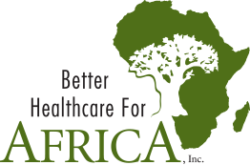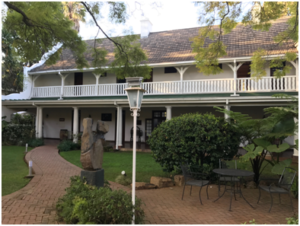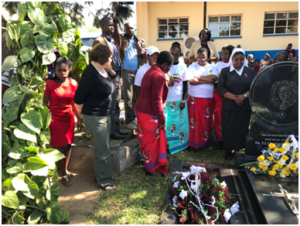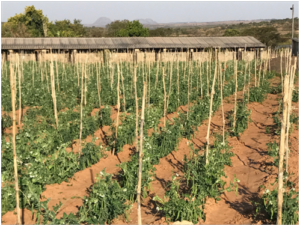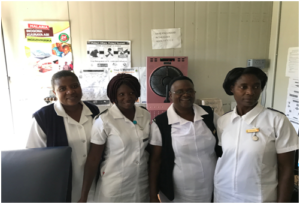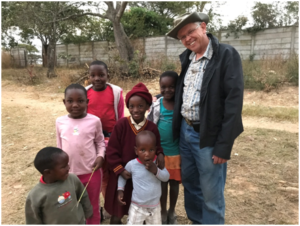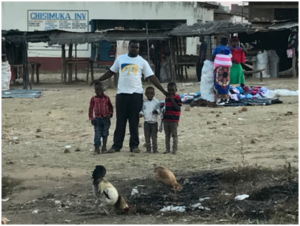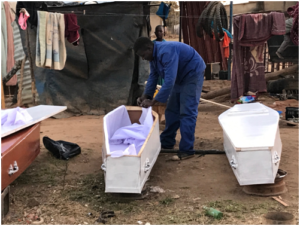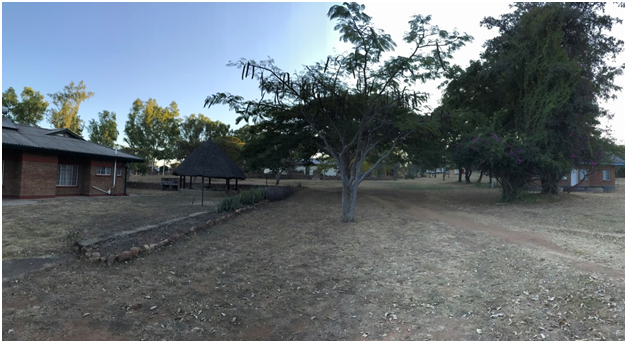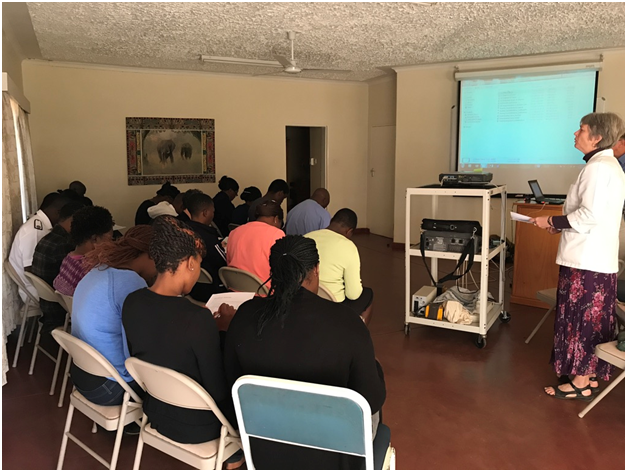The flight was longer than usual. Initially a quick hop to JFK and then an A380 to Dubai. Great plane, easy ride, soft landing, but….The good news is that the flight was comfortable; the bad news is that it was delayed, and my baggage didn’t make to Harare with me. Fortunately, I kept a change of clothes with me, including slacks and a sport jacket, so I was suitably clothed for the lecture that was scheduled for 1:30 PM on July 21.
On Thursday the 20th we were met at the airport by Dr. Anna Nyakabau and her brother, Anthony, who drove us to the Bronte Hotel, sans my suitcases. The hotel is lovely facility graced with lush greenery, several restaurants, and looking very much like a colonial era watering hole. The rooms were adequately furnished, and to boot, they had single malt whiskey in the restaurant!
In the morning we were taken to Anna’s private clinic where we met several women receiving chemotherapy. Each had presented with large tumors, and each was curious about their treatment, extremely polite and interactive. I had little to offer beyond agreement with their current treatment plan.
Into the next world we went, as we drove to Parirenyatwa to partake in a gyn oncology tumor board: two cases of advanced vulva cancer and one of carcinosarcoma of the uterus that was widely metastatic. Later that morning we had an engaging meeting with the leadership of Island Hospice. We were met with enthusiasm as we discussed the possibility of developing a liaison with St. Albert’s Mission Hospital (SAMH) for the purposes of educating staff in palliative care. A follow-up meeting to sharpen our focus is scheduled for later in the week.
My lecture on Friday afternoon was preceded by courtesy meetings with the Dean of the medical school and the Associate Dean for Continuing Education (Dr. Gwanzura). The latter suggested he had travel funds available and intimated the possibility of organizing training experiences. I hope that is the case. The lecture was well received by a surprisingly large audience, SRO, with numerous compliments sent to Anna afterwards.
Back to the Bronte and a meeting with Thandiwe B…. a research administrator who will help us finish the application for the HPV Typing project we are planning at Karanda. She exudes competence and familiarity with the system, which left me reassured, albeit still a bit skeptical that the last barrier has been crossed.
On Friday evening, we were dined regally at Anna’s home, a lovely ranch style house on beautifully sculpted grounds. Her sister-in-law catered an expansive menu of local vegetables and meats, wines and music provided by Anna’s delightful

Tende Dera (Nyakabau) serenading at dinner (Darrell Ward on the left and a family friend on the right.
teenage daughter Tende. Piano, ukulele, and xylophone, superseded by drawings that suggested a latent talent that hopefully will emerge in the coming years. Others present were two of Anna’s colleagues and the widow of a former patient, who is now a close friend. Lots of laughter and warmth exuding from all quarters.
The long drive to St. Albert’s began after 8 AM the next morning and took 2.5 hours. Along the way, we were stopped by police who demanded a $10 fine. Anna, who accompanied us, was incensed at this. She explained who she was, what she did for the country, as she phrased it, and lo and behold, he let us go, sans a fine!
We reached SAMH just as the celebration for Dr. Tarira’s commemoration began (the 5th year anniversary of her death). We sat at the place of honor with her family, friends and religious leaders.
More than 600 people were present to partake in singing, dancing, and talks about cancer prevention. Hester and I had donated $1,000 to this event and were thanked profusely since, in essence, this made it happen. Most of the speaking was in Shona, so it went right over us. It was clearly a well-appreciated event for the community intent on acknowledging a heroine.
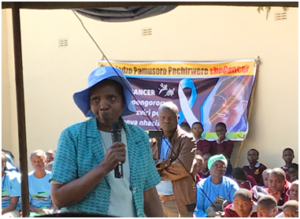
Dr. Julia Musariri at Dr. Tarira’s memorial service, photo of Dr. Tarira on the wall (above) and at Dr. Tarira’s grave site (below)
During the late afternoon, as the sun’s rays trended to the oblique, we toured the farm. An amazing transformation! A new farmer is in charge, and there have been good, prolific crops that were luxuriant, new acreage opened for planting and a fish farm is in place for raising tilapia. An exciting dimension was seeing the siting of the water pump we purchased and the embellishment of the water arrangements for the hospital and town.
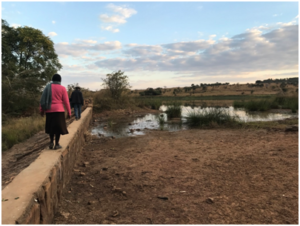
Julia and Darrell on the dam that creates the reservoir that serves as a source of water for the hospital, irrigation for the farm and water for the mother’s home
Dinner with Julia at her home was a bit different than on prior visits. She and Melania are living with at least 4 teenage girls who are novitiates. They are shy, bordering on morosely quiet, so carrying conversation during dinner represented more effort than before. One night I was asked to say grace before dinner…made it up on the fly, but no mention of JC as that is not my metier, but it sure represented a change from this crowd’s usual practice. It was well, or at least politely received.
Monday the 24th was a day to tour SAMH, re-acquaint ourselves with many friends who exuded appreciation for our help with many projects, the cancer screening program being among them as well as the water project. We toured the campus and saw the equipment made possible by the Payne Foundation gift (lab equipment, Genxpert, auto-analyzer, Coulter counter, fume hood, radiology unit, blood pressure cuffs, rehabilitation and orthopedic (casting) equipment).
During the late morning we met with the VIAC staff and reviewed their progress and problems, some of which are easily attended to and others less so due to their cost. What is truly astonishing is that over the three plus years of screening, we have screened 8,000 women, many have been found to have pre-malignant lesions, and about a third have been treated at SAMH, some elsewhere and, unfortunately, some lost to follow up. The nursing corps must be the envy of the nation in that many other hospitals are sending their staff to be trained. What a source of pride!
A surprise is that we were asked to make copies of our passports so they could sent to the government district office. For what, who knows, but they must be suspicious of foreigners.
Dinner at Julia’s tonight, then another day at SAMH, then head to Harare on Wednesday for meetings with the Island Hospice people, a Lancet Lab executive and possibly the CEO of Pari.
Tuesday July 25
A slow and less scheduled day…time for reflection, some writing and beginning to prioritize the many needs that we have been introduced to. The electricity has just returned after being off for 24 hours. For we westerners that is a disconnecting experience as life returns to a pre-twentieth century pace….well almost, since there are back-up generators for essential things.
After breakfast Melania, the social worker hurried to us asking that we come by the rehabilitation department where a group of disabled were gathering to be fitted for wheel chairs that were obtained through the generosity of the Rotary Club of Australia. The scene was one of pathos, suffering, caring and concern on the part of parents and onlookers. In fact, it was reminiscent of scenes one sees in Delhi, with one all-important distinction: These individuals were being cared for tenderly, and with great concern for their well-being. There was no suggestion of taking advantage of them at all. The leader of the organization caring for them is a Zimbabwean man who was eager to describe the needs of these individuals, their domiciles, some in villages with family and some too impaired to be on their own and thus, live an institutionalized existence. This was heart rending.
Wednesday July 26
A long, interesting day replete with unexpected twists and turns…none dramatic but emblematic of working in a third-world country. We awakened at 5:30 to meet Lawrence, our driver, who was to take us to the Bronte Hotel where we were scheduled for hospice home visits, and meetings with the CEOs of Parirenyatwa and Lancet Labs. The ride to Harare was uneventful other than for stopping at the site of a major wreck that occurred yesterday when a vehicle veered out of its lane (on this narrow, shoulder-less two lane road) and hit a combi head-on. Eleven people died! Devastating to gaze in terror at the burnt hulks of two vehicles. One of the dead is known to the St. Albert’s community since it was Mr. Adkins brother.
After dropping Darrell and Megan off at the Island Hospice, Anthony met me at the very same place, brought me to the Bronte and we had a cup of coffee. His phone rang, telling him my meeting with the CEO was cancelled due to his illness. Anna met us, and we then went to the Lancet Labs, a large privately held chemistry, pathology and hematology lab. The principle with whom I met, Dr. Matuke, was delightful, forthcoming and overtly interesting in helping and collaborating with mission hospitals…although the price structure of their services is determined by their board. I had asked for a negotiation for a discount; of more interest to me, I described my vision for tele-pathology in which samples prepared at the rural hospital would be transmitted through digital microscopy to Harare, or the US or Europe, where an interpretation could be made. She was enthusiastic, although the realities of internet capabilities were immediately focused upon, since the bandwidth available may not be suitable. This can be looked into. My plan is to discuss the possibilities with Dr. Julia Musariri at St. Albert’s, and make contact with my source who at least some months ago, had a Nikon digital microscope and camera available for donation. All agreed this would be a great boon to the rural hospitals.
From there Anna showed me her new consultation facility, a very attractive remodeled building that is tailored with a consultation room enhanced by a massive, quite lovely mahogany desk, a chemotherapy infusion area and a single private room. The wrench in the ointment is that her loan has been depleted, and she has not yet been able to install a proper fume hood need for preparing chemotherapy. The lessons here, as in much I’ve learned these past few days, is that Anna is a remarkable capable, hard–working, ambitious person. She owns several properties, of which this is only one, although this one is her most ambitious development project to date. All this from a young woman raised in a rural village in Zimbabwe, whose father was a farmer and who had to pull the oxen on the farm as the fields were being tilled. Falter once, I was told, and her father was screaming at her. Who would know the wizened, weathered sweet looking man who joined us at dinner at Anna’s home several days earlier was the disciplinarian he once was?
I returned to Island Hospice and there met with Dickson, a dear friend of Anna’s who is also trained in palliative care. My goal was to learn if an educational connection between St. Albert’s and the expertise at Island Hospice can be made. He described several options that reduced to some folks going into Harare for a number of days or the reverse, we agreed the latter option would be far better. They will rustle up the fee schedule for such a visit and I will discuss with Julia. All concur that given the late stage of disease that patients often present with to St. Albert’s, and the urgent need for palliative care, this could be a very worthwhile undertaking.
I returned to the Bronte for check-in and relaxation for a short while and then left for dinner with Anna, her brother Anthony, who has done the lion’s share of driving us around, her friend and colleague as well as her colleague’s husband. The three of us were present along with the 5 Zimbabweans: conversation was robust, filled with lots of thoughts of how to improve the worlds we each inhabit….more on that later.
Tomorrow, I am scheduled to meet Anna and her students at the radiation department at Parirenyatwa and discuss challenging cases. Then, off duty for the return to St. Albert’s, and later in the afternoon, leave for Karanda Hospital where we will overnight, put on Darrell’s video course about cancer, and review the cervical cancer screening program.
Thursday July 27
Early wake-up thanks to the alarm, then breakfast at the Palm Restaurant and off to meet with the registrars at the Department of Radiation Oncology at Parirenyatwa. The entrance is filled with patients waiting to be seen, not dissimilar from the waiting rooms in hospitals at home with a notable exception. The lone white in a sea of Africans is at once an unfamiliar site, yet appropriate and in its way, wonderful. At a superficial level I can sense the “scent” of apprehension in the air-space surrounding the patients, self-imposed patience, and an unmistakable look of “anywhere but here.”
Meeting with the registrars was enjoyable as they presented a difficult case of advanced triple-negative breast cancer in a patient also newly diagnosed with HIV infection with a low CD4 count. We launched into a discussion of the optimal evaluation to confirm the diagnosis and address the concerns about HIV infection in this context and possible treatment. Discussion then moved to hypothetical patients with the same presentation and ER+ disease. All in all a stimulating start to the day, following which we went to the Bronte, picked up Megan and Darrell, and proceeded to St. Albert’s.
After lunch at St. Albert’s we met with Julia and Melania to sum up our visits to Harare and the hospital with specific programmatic initiatives in mind. The VIAC room needs new solar batteries; when the VIAC nurses and driver do outreach to rural clinics as part of the cancer screening program, need lunch provided; and a VIAC camera needs replacing, all of which we committed to attend to.
Our visits to the Island Hospice was expressly to sort out their willingness to engage in training of hospital nurses, and what is the fee schedule for several half-day seminars/workshops, followed weeks later by intermittent field trips to accompany a nurse making home visits. The hospice team expressed interest and Julia endorsed the idea of growing expertise in palliative care as important. After our departure, I have learned from the Director of Island Hospice that they have been in touch. A good start!
Our discussion then extended to water at St. Albert’s. This is the hospital’s most vulnerable need since without adequate water the institution cannot function. This was made graphically clear to Julia when there was no electricity for 2 weeks. The solution is to install a solar powered water pump. Initially, BHA sent $2,000 since that was the presumed cost. However, the actual cost is closer to $8,000 so the thinking caps will be donned. Lastly, in the sphere of water access Julia has championed the idea of having water tanks dedicated to the hospital and not have the hospital’s supply shared with the needs of the school or the homes in the immediate vicinity.
We will consider options for coming up with this contribution since it represents an essential requirement.
Lawrence drove us to Karanda for a late afternoon arrival in preparation for reviewing the VIAC program there, as well as hold workshops for the cancer education course that Darrell has assembled at Ohio State. The road as usual is 1 1/2 lanes, pot holed, and meanders through rolling hills, unusual mountainous rock formations in the distance, many rural homesteads, and hundreds of local people of all ages walking along the road. Occasional cattle cross, oxcarts pulling heavily laden wagons are common, as are women carrying inordinately bulky aggregations of twigs and branches for the cooking fires at home. We make our way through the largest nearby town, Mount Darwin and head to Karanda. The visit tomorrow is to present a cancer primer course to nurses in the form of videos that Darrell has developed at Ohio State’s e-learning center and for me to get an update on the Karanda cervical cancer screening program.
We settled into the guest house at Karanda, a remarkably spacious and commodious facility that houses a conference center as well. We learned that the local physician overseeing the program, Spencer Mamvura, is scheduled to be on leave tomorrow. Happily he came by at 9PM to discuss the program and apologize for not being present tomorrow.
We reviewed the summary report that was presented to me, as compiled by the nurses. A few take-home messages from the perfunctory data shared with me include the fact that they have screened 2,095 women in 18 months. SAMH has screened 7,995 in 3.5 years. The percentage of VIAC positives are 4.8% at SAMH and 5.2% at Karanda. The number of HIV positive patients range around 10% in both institutions and the fraction of women who are positive for VIAC at SAMH is 10%. These data are yet to be determined at Karanda. The most impactful data are those indicating that the fraction of women who are VIAC positive that received either cryotherapy or LEEP is over 50%. It is 35% at SAMH.
We were greeted by Judy, the former head of the nursing school who took us to the guest quarters, we were given a brief summary of the VIAC program’s activities, and Kiersten, a physician’s assistant who will moderate the video presentation stopped by to say hello and get oriented. The cooks came to the guest house to prepare our dinner and a quiet night ensured. The ambience at Karanda is spacious, restful, away from the hospital, less chaotic than at St. Albert’s on superficial observation, and far better endowed. The guest house is luxurious by comparison, large baths, hot water and a sizable well-appointed kitchen. Lovely plantings of trees and shrubs lend a soothing and beautiful tone to the place. The staff is composed of highly motivated nurses and physicians, all of whom exude an element of missionary zeal and all of whom are quite religious. My primary motivations being largely or entirely humanitarian causes me to notice this distinction, and confess to being a duck out of water. So be it! It is the substance of the work that counts.
Friday July 28, 2017
The cancer education course was delivered in two segments of two hours each. The five short videos were well received, and following the showing I served primarily as a source of answers to questions, and Darrell was a source of education and perspective. It went well and was appreciated by the leadership and the nurses who made up the audience. It was shocking how little they seemed to know about the risk factors for cancer, its causes, prevention strategies and treatment; these were the areas emphasized. In all cases the discussion was steered towards disease types relevant to this nation.
I was hoping to get further details on data generated by the VIAC program, but the physician, Dr. Mamvura was off, and Dr. Paul Thistle one of the senior physicians at Karanda and an Ob-Gyn specialist was on leave in Canada. The dedicated VIAC nurses were each in the morning or afternoon sessions of the course. I was unable to get as many details of the program as I had hoped for.
At the day’s end we loaded into Kiersten’s car and drove to St. Albert’s. A fascinating drive ensued not least because dusk was approaching with great rapidity, and the dirt roads made their negotiation treacherous. Avoiding people, cattle, dogs and children was a challenge. This is an area in which rural people are living in classical ways without the accoutrements of modernity. Electricity if present is provided with generators. Farming is the essential means of subsistence. The traditional homes are often circular, many are thatched and there is a cooking hut, for which women are often out early in the AM gathering wood for the fire, and other women or girls are walking to the nearby bore hole to bring water to the family. The latter occurs twice daily.
The land being farmed and lived on is not owned by the family that occupies it. They are users. While consistent with the cultural heritage of these tribal people in which land is not something you own, but use, the reality is that the government has the right, and apparently has exercised it on many occasions, to force them to move on, without cause. The proximate cause and most cynical explanation goes like this: either minerals have been found on the land, or it is needed for propagation of a crucial crop the government feel is of paramount importance.
My last dinner at St. Albert’s for this visit featured the usual fare: well done beef, fresh lettuce with oil and vinegar, rice, carrots, hot sauce and beer. The vegetables are wonderful since they are fresh out of the ground. Julia baked a cake and ice cream was added for good measure. Good feelings all around.
The serious turn in the conversation occurs when we discuss the state of the economy and Julia’s role. While St. Albert’s appears to be growing, and enjoys a stellar reputation, bills are often in arrears and a constant source of anxiety. The hospital’s annual electric bill is $117,000, and she cannot come close to it. The government is similarly in arrears and has not paid for the electricity it imports from Mozambique (if it is to be believed, a country more poor than Zimbabwe).
Julia’s role is changing. She has been appointed as the coordinator of all Catholic Hospitals in the diocese of Chinoyi, and was technically retired by the government 1 1/2 years ago. This change relates to her salary having been reduced, although she still gets modest funding from the diocese. Her pension, like that of most Zimbabweans vaporized after the 2008 economic recession, so she is rebuilding very slowly. What will happen to SAMH? She says she thinks the archdiocese may be searching for her successor, although that is not official. There is no word on that. Thankfully, Julia is committed to staying on the job. Clearly loving the work, the hospital and the poor, she is consumed with worry for the rural poor in the country.
Late morning July 29 came quite quickly. A shower, finish packing, a quick hello and farewell to Stanely Tapesana, a physician at SAMH and graduate student in public health at the U. Zimbabwe. He lives on the campus; she is a nurse at the hospital and the mother of twin boys, and he will return as the District Medical Officer. A good choice, since Stanely is upstanding, research oriented, a good clinician and energetic. A farewell hug to Stanely, Lawrence loaded my bags, and the truck starts rolling. In our line of sight are two women carrying large pails of water on their heads as they head home after filling up at the bore holes. I confess to a surge of emotion as I saw them, and write this now. The image is metaphorical for a people living under the harshest conditions, working diligently to survive while maintaining a sense of outward calm, composure and good humor. A smile is far more often their countenance than a frown.
Until I return…
